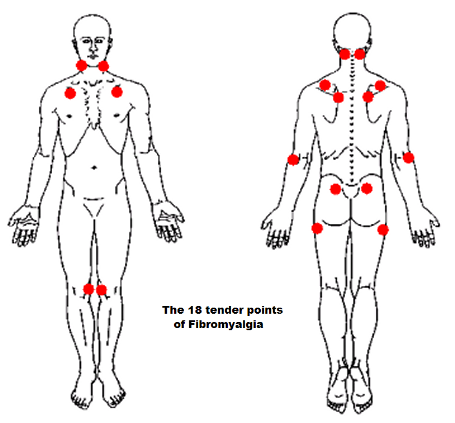Enthesitis and Enthesopathy in Fibromyalgia
Why enthesitis may not be recognised
The enthesis has relatively few blood vessels, which reduces the magnitude of swelling or inflammation at attachment sites.
Therefore, patients with skeletal pain may not have obvious abnormalities that explains their joint pains.
Blood tests carried out by doctors including ESR and CRP may be normal.
X-ray's are also normal in many cases of enthesitis.
Even sophisticated tests including MRI and scintigraphy may be normal.
What is Fibromyalgia?
Fibromyalgia is characterised by generalised joint pains and an increased sensitivity to pressure over joints and bones that causes discomfort.
The diagnosis is made on the patient history, absence of an alternative diagnosis and tender spots (Figure).
 |
| To diagnose fibromyalgia the physician elicits tenderness at certain locations around the body. As can be seen there is some overlap with fibromyalgia tender spots and with sites of enthesitis. |
Blood tests are also normal in Fibromyalgia.
The points of tenderness in Fibromyalgia and enthesitis may overlap and this can lead to confusion with the diagnosis.
When might a Fibromyalgia patient actually have Enthesitis?
Most patients with fibromyalgia don't have enthesitis. However, on occasions enthesitis is misdiagnosed as fibromyalgia because of the factors listed above.
The following fibromyalgia groups need to be carefully evaluated for enthesitis and enthesopathy as an alternative diagnosis:
- All patients with psoriasis patients
- Patients with history of inflammatory bowel disease or Chrohns disease
- Patients with first degree relatives with psoriasis
- Patients with profound early morning stiffness which has helped improves as the day goes on
- If anti-inflammatory drugs are very effective in Fibromyalgia then enthesitis should also be considered
Very little research has been carried out on the mis-diagnosis of fibromyalgia in subjects who actually have enthesitis.
It is likely that this a primary enthesitis group is fairly rare in fibroymalgia but still very important.
Vigilance is needed by clinicians to pick up cases of Spondylarthropathy including Ankylosing Spondylitis and Psoriatic Arthritis in patients with joint pain that superficially looks like fibromyalgia.
Fibromyalgia and associated enthesopathy
Patients with fibromyalgia do get isolated enthesopathies like the general population. These enthesopathies include tennis elbow, golfers elbow and trochanteric bursitis.
Because of the fibromyalgia the pain perception from these problems may appear worse. Surgical procedures for enthesopathy should be avoided in general in this setting.
Enthesitis and associated Fibromyalgia
Patients with inflammatory disease of the enthesis may develop fibromyalgia. This may be associated with a poor sleep pattern and low mood.
The development of fibromyalgia may be the reason for the apparent loss of effect of drugs including the anti-TNF agents.
This is a result of doctors wrongly attributing pain to enthesitis when it is actually due to Fibromyalgia.

